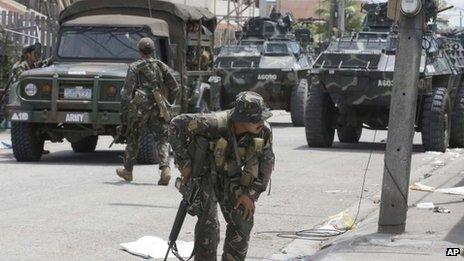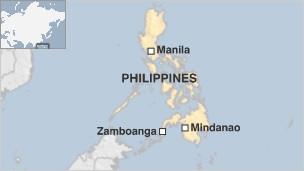Philippines clashes: Residents flee Zamboanga
- Published

Government troops and the rebels have been exchanging sporadic gunfire
Philippine troops have continued to exchange gunfire with Muslim rebels in an ongoing stand-off in the country's south, as thousands of residents flee.
At least nine people have been killed since the fighting began on Monday in Zamboanga city in Mindanao.
A faction of the Moro National Liberation Front (MNLF) has moved into the city, with rebels now holed up in a number of communities.
Most flights and ferry services remain suspended in the city.
The rebels are reported to be in a number of villages, along with civilians. Local reports say that some houses in rebel-held communities have been set on fire.
Thousands of residents have fled to safety, with at least 13,000 people seeking shelter at the Zamboanga city sports stadium, local officials say.

"We're trying our best to provide decent facilities for them," social worker Beth Dy told Agence-France Presse (AFP) news agency, but added there were only four portable toilets at the venue.
Other residents have sought shelter at churches and schools. The president has sent the social welfare secretary to the area to help in relief operations, officials say.
'No head count'
The rebels are reported to be holding some civilians as "human shields", but it is not clear how many.
Zamboanga city Mayor Maria Isabelle Climaco in a statement said that the MNLF rebels were holding about 100 civilians and that "efforts to negotiate with the hostage-takers... are ongoing".
She earlier said that the rebels wanted the international community to mediate.
Four countries - the US, the UK, Canada and Australia - have issued advisories against their citizens travelling to Zamboanga and parts of Mindanao.
A senior Philippine official, meanwhile, said that details on the ground were sketchy.
"We have not been able to enter, nobody has been able to enter these areas," the Philippine Daily Inquirer newspaper, external quoted Interior Secretary Mar Roxas as saying.
"There has really been no headcount. Most of the details that have been repeated come from media. The intelligence units of the military and police are trying to validate this."
One of the leaders of the current attack is a top aide of MNLF founder Nur Misuari, Habier Malik, military spokesman Lt Col Ramon Zagala was quoted by AFP as saying.
The MNLF members arrived by boat in the city early on Monday and had tried to raise their flag above Zamboanga's city hall, military officials said.
Nur Misuari founded the MNLF in 1971, with the goal of fighting the Philippine state for an independent Islamic nation. The MNLF then signed a peace agreement with the government in 1996.
However, Nur Misuari has complained that his faction has been marginalised in a peace agreement currently being negotiated between the government and another insurgent group, the Moro Islamic Liberation Front (MILF). Last month, he declared an independent Muslim state in the southern Philippines.

There were reports of residents being used as human shields
Misuari has yet to comment on the violence and his whereabouts remain unclear.
His forces used Zamboanga residents as human shields before, in 2001, to secure safe passage after a failed uprising.
Zamboanga city resident Justin Paber, who lives about 5km (three miles) away from the site of the fighting, told the BBC he could hear the sound of explosions.
Mr Paber, who works as a doctor, said a government hospital near the villages where the rebels were located had had to be closed and patients evacuated for safety reasons.
"The city is trying to function as best as it can to provide the basic needs of its residents, but it's hard because there is always a sense of fear that the condition could worsen," he said.
The fighting has also affected the flow of basic goods around areas near the city, as some shops maintain sporadic opening hours.
- Published10 September 2013
- Published9 September 2013
- Published9 September 2013
- Published14 February 2013
- Published8 October 2012